Final Report for FNC13-905
Project Information
Small dairy goat farms can benefit from growing their own live fodder, especially during the periods of the year when there is no grass for grazing. This project was not able to establish that the live fodder improved the milk production of lactating goats. The evidence for that was not obvious. The economic benefits of the project, as to whether costs involved with growing fodder on a scale large enough to feed goats on a daily basis, are also not easy to show. The increase in milk production was not substantial, but purchasing conventional seeds (non organic or non GMO) and growing them was not costly.
The overall perspective gained by this project is that as a year round food supplement, perhaps 25% of the goats food, live fodder is a good thing. It cannot totally replace dry matter (like feed and hay), but it is nonetheless a healthy supplement. The design of the system, as evolved over time by the owner of the farm and her staff is a good and efficient one.
The dairy goat farmer Linda Dushane improved on the fodder system funded by NC-SARE and continues to feed her dairy goats fresh fodder, even as the weather in the north and central Illinois turns consistently cooler with the approach of winter. Photos and videos of the new system are included under the section Future Recommendations)
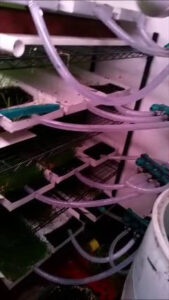
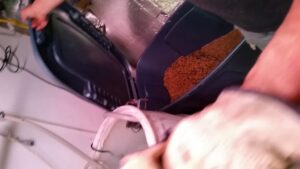
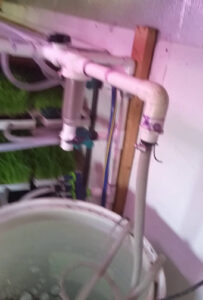
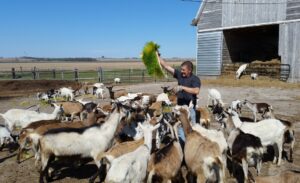
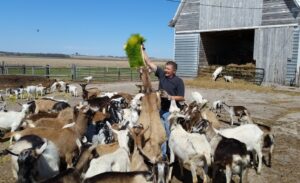
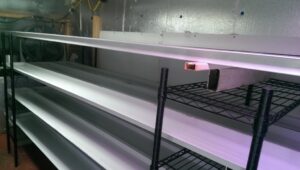
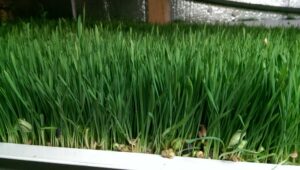
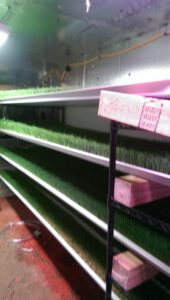
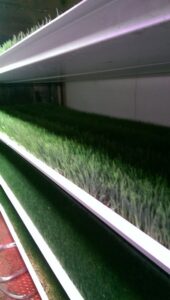
Introduction:
Small dairy goat farms – those with limited acreage – need to supply feed and hay from sources external to the farm. Growing live fodder hydroponically is one way to supply live food year round to the dairy goats. Linda DuShane, a dairy goat farmer for over 10 years felt that the lack of live food for her goats during winter months was not a good thing. Additionally she wanted to explore non conventional feed for the goats, and thought that growing live food would be less expensive than using organic and/or non GMO feed.
One way to grow food year round is to use hydroponic methods. In a temperature controlled environment, sprouts can be grown with just water, and then harvested after one week to feed to the dairy goats. The hydroponic setup can allow racks of trays to take minimum horizontal space. For limited acreage farms, that is a big plus.
Linda decided to retrofit an RV trailer with more insulation and new plumbing and electrical connections. This allowed a 14 by 8 ft space for the racks, watering mechanisms and seed storage. The setup allowed for the growing and harvesting of 70 lbs of fodder per day, all year round. The main costs involved labor, seeds and electricity. With unmetered water available at her farm, water was not a financial concern.
Since one important objective was to see if growing fodder hydroponcally would be less expensive than going with all organic feed, there is the cost factor to look at.
In our region where there are no local suppliers of organic feed (such as Linda's area), to obtain organic goat feed via mail order is possible, with shipping adding to the overall expense. Five 50 lb bags of organic goat feed would cost $145, plus $100 for cheapest shipping. That would amount to about $250 for 50 lbs, or $1.00/lb. So, feeding 60 goats 1.5 lbs a day would require 90 lbs of feed, which would cost $90. Lactating goats require more feed, so the cost could go higher, to over $100 a day for the organic approach.
The local non-organic feed is much cheaper, about $ 15 for 50 lbs, and can be easily obtained locally. This is 34 cents a pound, or $31/day for 90 lbs. With some of the goats lactating, the daily cost could rise to $40/day.
Hay is another item that can be organic and not organic. Linda is not able to obtain organic hay in sufficient quantity and so relies on non-organic hay. Goats always need hay, regardless of other sources of food, such as feed, sprouted fodder or grass to browse.
Research
The methods used to grow and feed the fodder changed over the time of the project. The outline below provides the methods that were found to be best.
The retrofitted trailer was insulated and supplied with 120 V electricity. The wires supply power to the water pump and to the heating or the air conditioning (depending on the time of year). A three in one unit that heats, cools or dehumidifies is used to maintain climate control in the trailer.
The two racks have trays that are either 11 foot or 7 foot long and 6 inches wide. There are four levels for the trays, and with three of them side by side, there are twelve total trays on a rack. The 11 foot trays can hold 130 lbs of fodder when fully grown. The four foot trays hold 84 lbs of fully grown fodder.
The water system used is call the push method. Each rack has a watering tube at one end, that pushes water from the tube down through the tray. The trays are slanted at a 3 degree angle so the water is drawn by gravity from one side of the tray to the other. There are other methods of watering, including over head drip and overhead spray, but the push method worked best for this project.
e) Humidity is not controlled, although a 3 in 1 unit (heat, A/C and dehumidifier) could remove excess humidity. Even high humidity (70% and above) did not produce mold. The small trailer with so many trays growing sprouts always had high humidity even when the outdoor humidity was low.
f) Vinegar is sprayed on top of the newly planted seeds, to encourage faster initial growth.
h) Watering is done by pumping from barrels inside the trailer, so the temperature of that water is room temperature,
A thorough cleaning of the entire trailer is done once a week to eliminate any extraneous dirt or fodder seedlings that fall to the floor.
Since obtaining organic seeds to grow as fodder is also expensive, Linda decided to go with non-organic seeds and grow them naturally as fodder. Non-organic seeds, like the wheat, soybean and sunflower seeds she used in the trays to grow as fodder are comparable in price to non-organic feed. That means:
Once the fodder is harvested, then 1 lb of seed has grown to 7 lbs of fodder. That could mean that only 1/7th as many seeds are needed compared to feed. The reality is not quite that way, since some seeds don't sprout and the content of the sprout is largely water. The daily seed cost is less than the daily feed cost, but more like a 50% savings.
The expense of setting up the system, running it daily, using electricity to heat some times of the year and cool other times of the year negate any cost savings compared to non-organic feed. The daily labor cost is probably double that of just making feed available, Planting seeds, harvesting them, and overall cleaning of the trailer take 1 or 2 hours a day. Electricity costs vary greatly with the time of year. Water at Linda's farm is not metered, so that cost was not a factor for this project.
The daily costs for non-organic seed, labor and electricity are still less than using just organic feed, and the fodder is live food, available all year. It is grown naturally, but is not certified organic. Linda feels that year round natural fodder is important for her goats; even in summer months she has limited acreage for grass, and the nutritional value of the wheat/soybean/sunflower seed fodder is higher than the grass and weeds the goats graze on during warm weather. She is not so sure there was an increase in milk production by the lactacting goats. She will look for that impact again during the Spring and Summer of 2016.
Impact of Results/Outcomes
The most important accomplishment was creating a solid design for growing fodder Over the course of the project, different kinds of racks and trays and watering methods were tried. This resulted in a design that works well with with regard to mold (none), watering, drainage, cleanliness, seed growth and ease of harvesting.
The second main accomplishment was showing that fodder for dairy goats could be grown year round in a relatively small climate controlled space. The owner of the farm, Linda DuShane feels that goats benefit from live food during the months there is no grass or other forage. Plus the fodder grown is a complete feed for goats, and is healthier than just grass foraging. The chemical analysis of the fodder is posted as part of the SARE report.
A third accomplishment was the outreach to other parties through the website and direct contact with resettled refugee groups living in the Quad Cities area. There are numerous videos, photos and documents on Linda's farm website that provide practical information on how the project works.
The project was not able to show that the live fodder positively affected milk production. Linda knows what to expect of the milk production of her dairy goats, and she did not see any increase due to the feeding of hydroponically grown fodder. There could be other factors affecting that observation, and more research might establish other conditions where the live fodder does increase milk production.
Educational & Outreach Activities
Participation Summary:
On Linda's www.heartsquestgoats.com website, we have posted numerous videos and photos of the project. There is a blog that gives a narrative of the the progress of the project and its stages.
There have been two workshops, one in June and one in November. FFA groups were invited from neighboring high schools, as were ag students at several community colleges.
Notices about the workshops were sent to Extension and Farm Bureau offices in the surrounding counties. There is slideshow presentation from the second workshop that has been uploaded to the SARE website and Linda's website.
Members of refugee groups in this area from Nepal and Burma were shown the fodder system to help educate them about the potential of hydroponic technology for growing foods that they might like. Hydroponic methods are not limited to growing food for farm animals. There are a large number of greens and other vegetables and grains (like rice) that can be grown indoors. The refugee communities could become more knowledgeable of hydroponics and use these methods to grow foodstuffs they prefer that are not easy to find in local supermarkets.
As the SARE project comes to an end and the final report is done, we will notify all of the FFA, Ag departments at nearby community colleges, Extension and Farm Bureau offices of the final report and they can learn the full scope and conclusions of the efforts. Additionally, Linda plans on continuing to use the fodder system in the future, and interested parties are welcome to contact her about a visit and tour of the system.
Project Outcomes
Potential Contributions
For dairy goat farmers who have not enough acreage to allow consistent live green foraging in the warmer months, and for all such farmers who want a way of feeding live food to their goats during the cold months, the hydroponic system developed by this SARE project is a positive alternative. The effect on milk production was not measurable, but the value of live nutritionally balanced food instead of just dry feed and hay is of benefit to the goats in the opinion of the farm owner, Linda, who has had dairy goats for over 10 years.
Although the use of the fodder system results in a natural feed, it is not purely organic unless the seeds are organic. And, hay is another important part of the goats' diet. Linda used hay that was not organic. So, she did not have completely organic food sources during this project. If she had gone totally organic, her daily costs would have been high. Another goat farmer with more local access to organic seeds and to organic hay could still use the hydroponic method to develop completely organic foodsources for the goats, including the live sprouts.
The design of the system changed during the project, and the final design was more efficient for labor and for highest percentage of seeds sprouting. This design also resulted in producing sprouts with no mold. The setup and procedures developed by this project accomplish the job.
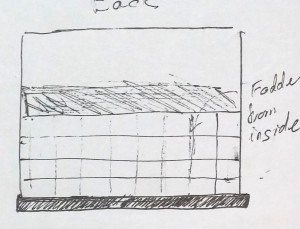 Rear View of Trailer - with feeding area
Rear View of Trailer - with feeding area 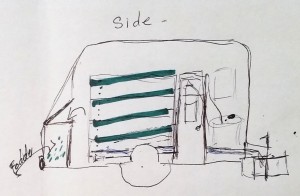 Side View of Trailer with Door
Side View of Trailer with Door 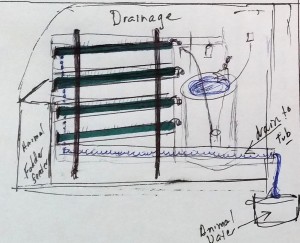 Inside of Trailer
Inside of Trailer 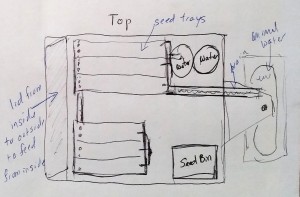 Top View of Trailer
Top View of Trailer
Future Recommendations
1) Since it proved costly to get organic/non-GMO seed in this part of Illinois where Linda lives, another project could look at the economics of using that kind of seed to produce fodder for dairy goats.
2) The outdoor trailer was a good starting point for a hydroponic space. But, a more insulated, more sheltered space would save heating and A/C expenses over the long term. A project that used an indoor space would have advantages.
3) The health and nutritional effects of live fodder on dairy goats during their kidding season should be further examined. The impact of the live food on their milk production was not evident during this project.
4) Feeding live food year round to boer goats, which are not used for producing milk, might be a useful extension of growing hydroponic fodder.
5) Hydroponic growing of vegetables and specialty crops for sale into the local farmers market could be done utilizing the technology this project explored.
6) This technology could be further promoted to refugee groups that are accustomed to traditional farming and would like to grow vegetables they like, but do not have the resources for large acreage.
7) Live year round food would be of benefit to other farm animals, like chickens and sheep, and projects could be developed for other farm animals.
.
(Linda continues to improve the fodder system to feed her goats. In August of 2016 she had a steel shed constructed and insulated to house a more efficient version of the hydroponic fodder growing system. Here are some videos and photos.)
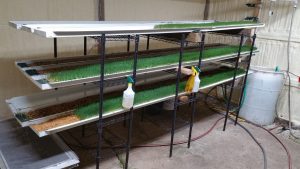 New, improved fodder system in steel insulated building.
New, improved fodder system in steel insulated building. 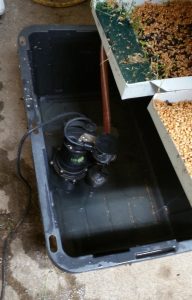 Sump pump used to move water out of the building.
Sump pump used to move water out of the building. 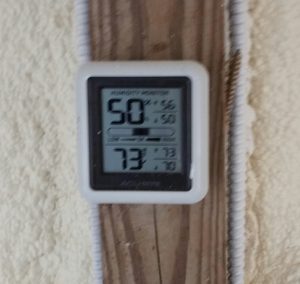 Humidity reading on top and temperature on the bottom
Humidity reading on top and temperature on the bottom 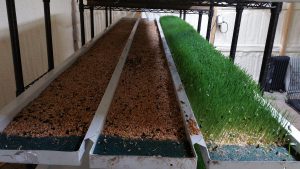 Fodder and Seeds, Viewed from the Long End.
Fodder and Seeds, Viewed from the Long End. 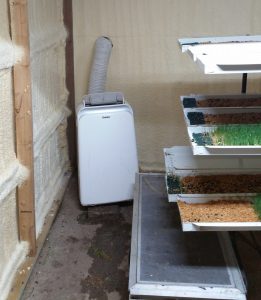 3 in 1 heater/AC unit keeps the building at the correct temperature.
3 in 1 heater/AC unit keeps the building at the correct temperature. 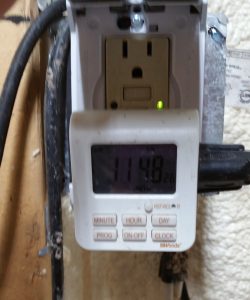 Timer that controls several times a day watering.
Timer that controls several times a day watering.